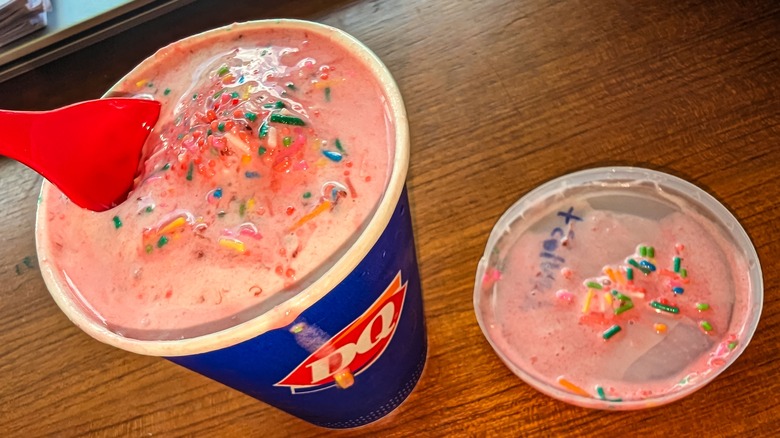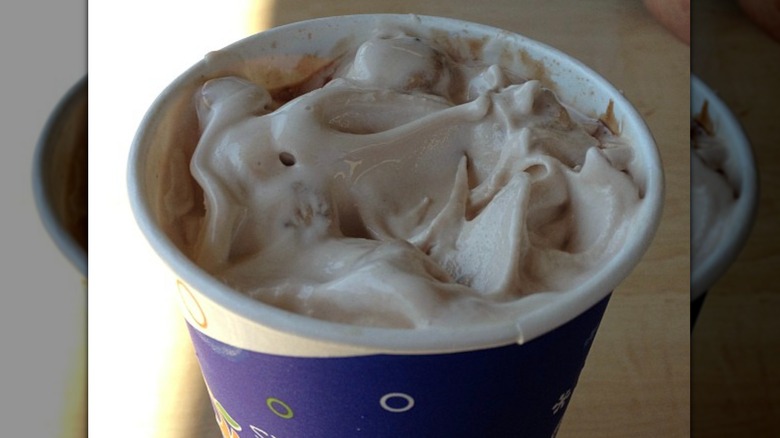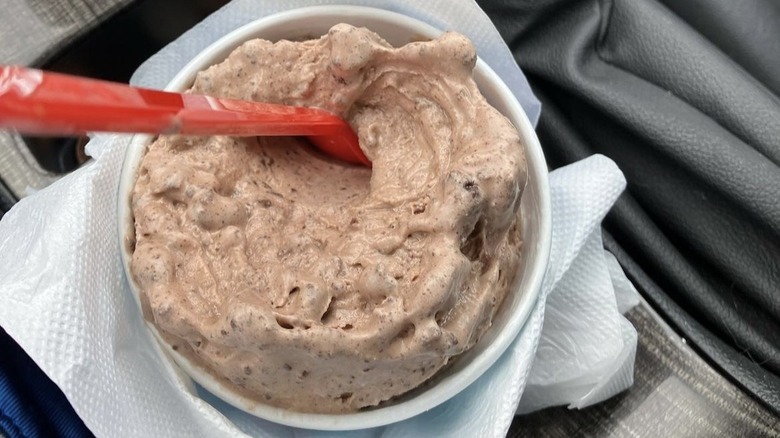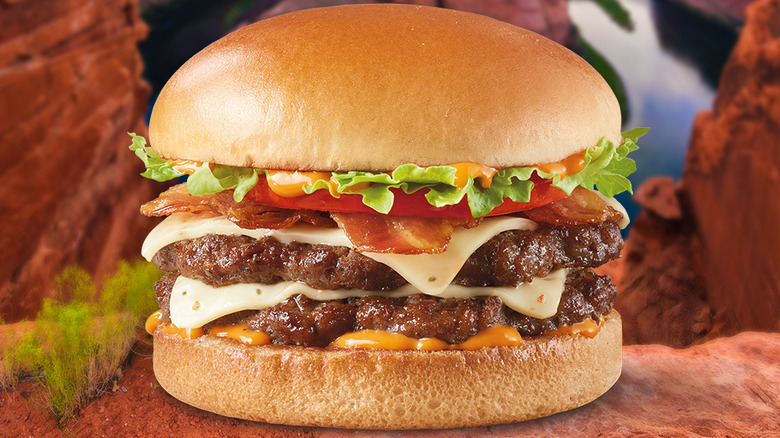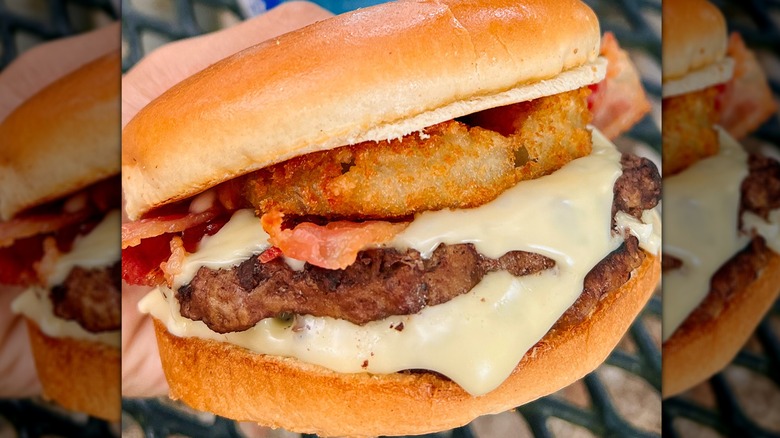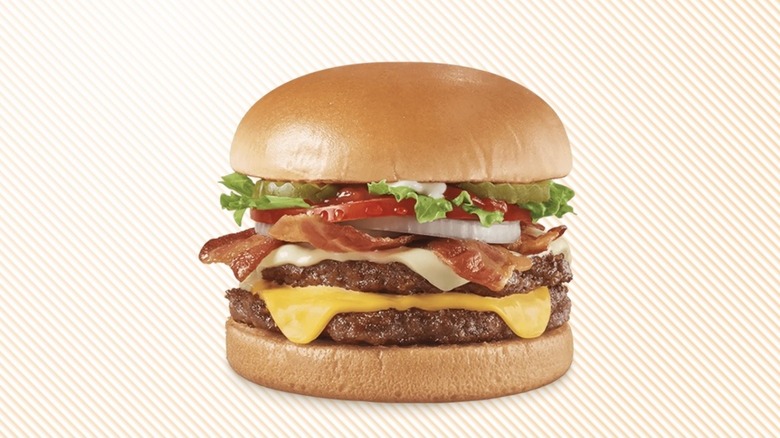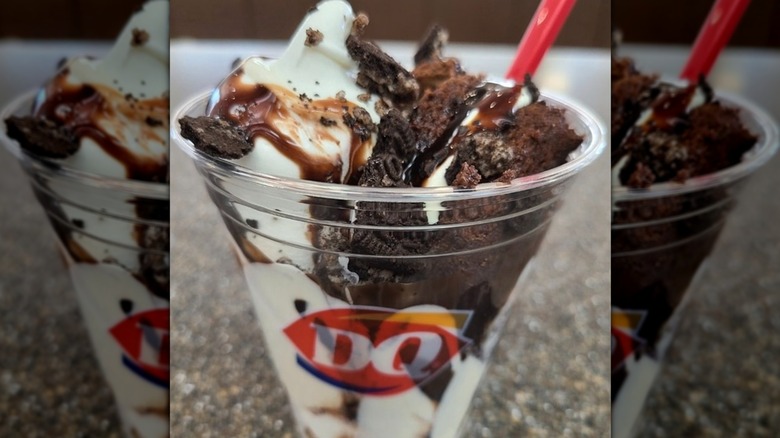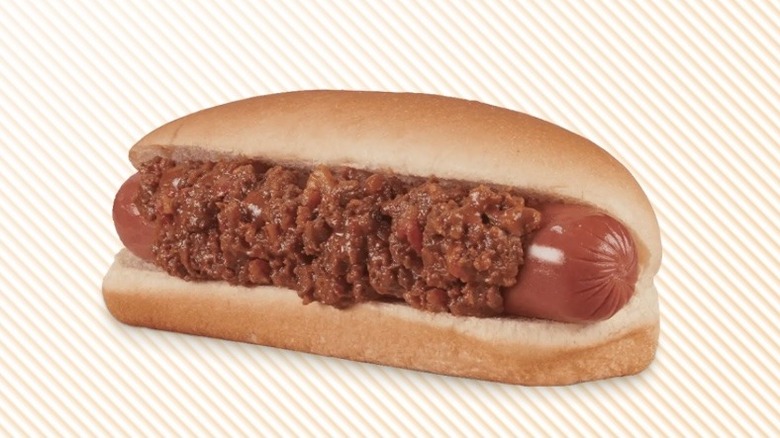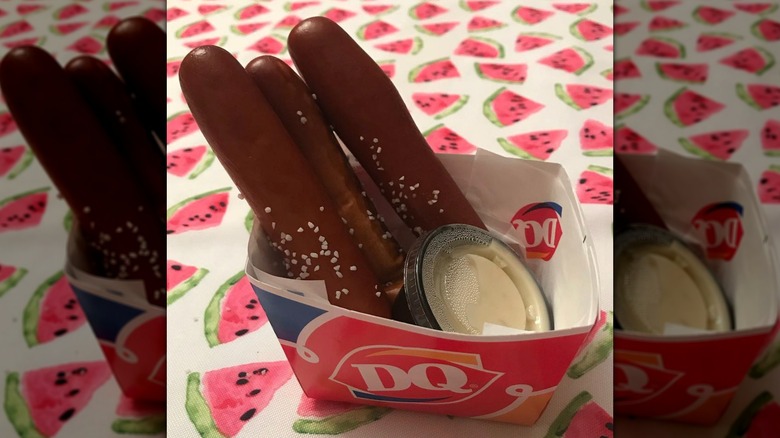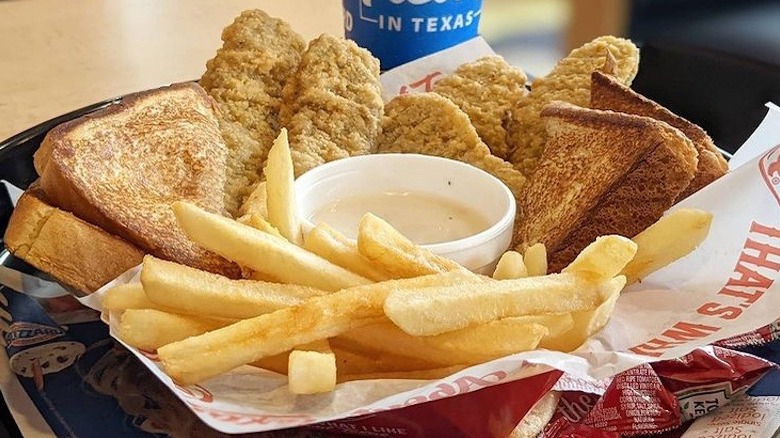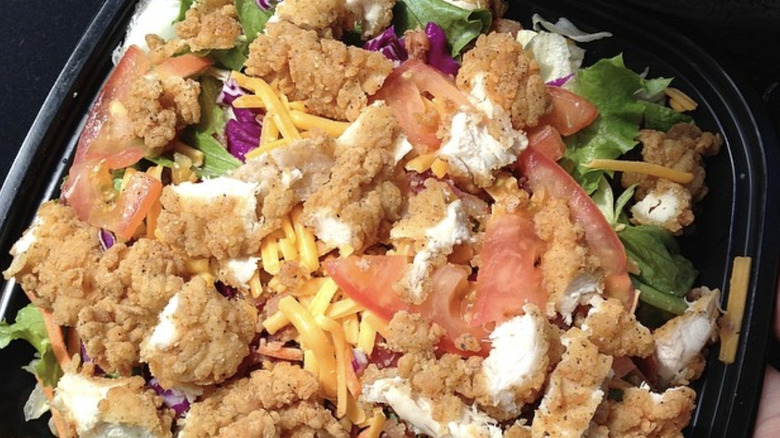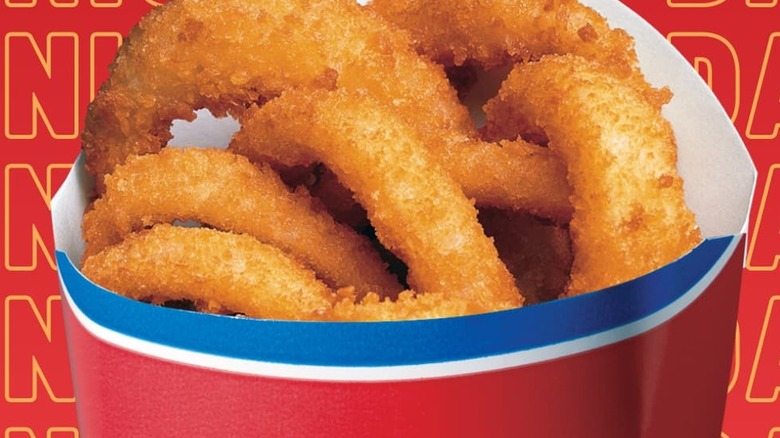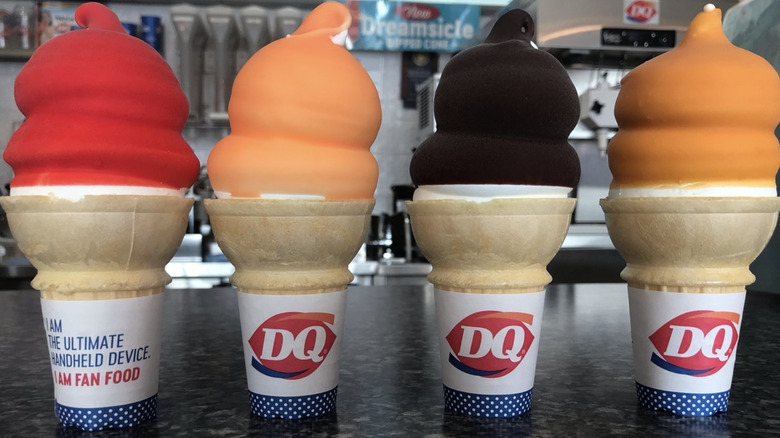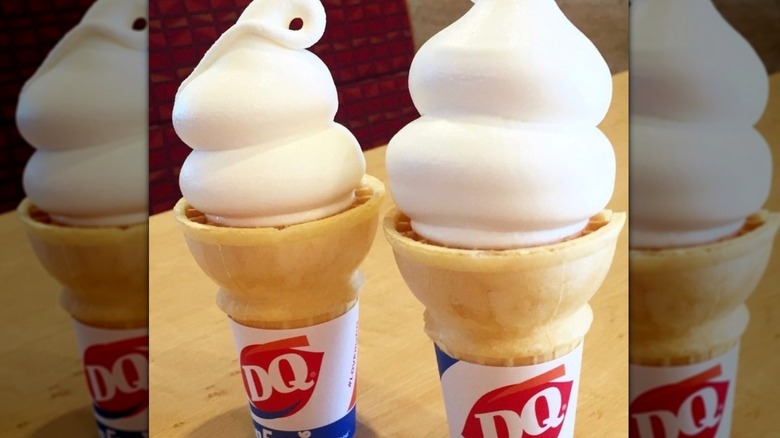13 Things You Should Think Twice About Ordering From Dairy Queen
In the mid-20th century, Dairy Queen conquered America with its soft serve-based, ice cream-approximating treats. Today, there are many reasons why one would choose Dairy Queen over its flashier, newer, more culinarily interesting competitors. Dairy Queen knows us better than we know ourselves, offering cost-effective, crowd-pleasing treats drenched in nostalgia and Americana; or maybe there's just an undeniable craving for a signature treat, like one of its many Dairy Queen Blizzard flavors, a Dilly Bar, or a Peanut Buster Parfait. Also, Dairy Queen's savory menu of burgers, fries, and hot dogs has its fans.
It probably goes without saying that, according to most any metric, Dairy Queen's food is not the healthiest. There is a lot of fat, sugar, and salt used to make those hot eats and cool treats, not to mention a fair amount of chemicals and industrial processes that might and probably should give consumers pause. Here are all the most eyebrow-raising items on the Dairy Queen menu that you might want to reconsider before indulging in.
Peanut Butter Cookie Dough Blizzard (Large)
The Blizzard ranks among Dairy Queen's most famous and popular creations. Occupying a place in between a milkshake and a sundae, DQ employees make a Blizzard with a hefty portion of soft serve and blend in any number of options, like candy, baked goods, or fruit. Every add-on contributes more calories and sugar to the equation, and no Blizzard packs a bigger wallop of both than a large sized Peanut Butter Cookie Dough Blizzard. It is so many desserts in one — soft serve plus cookie dough embedded with chunks of sweet peanut butter.
The USDA dietary guidelines for an average adult are based on a daily consumption of 2,000 total calories — of course, the amount of calories you consume (especially for good health) also depends on your height, gender, current weight, and exercise routine or activity level. The large Peanut Butter Cookie Dough Blizzard, intended to be eaten as one post-meal dessert, contains 1,650 calories, or nearly a full day's worth of energy, but again your body type, gender, and how active (or inactive) you are play a role. The federal government also suggests limiting added sugar intake to 50 grams a day — the biggest Peanut Butter Cookie Dough Blizzard available promises 148 grams of sugar, or about three times that guideline.
Brownie Batter Blizzard (Large)
Inspired by the phenomenon of unbaked, safe-to-eat raw cookie dough as both a snack on its own as well as an ingredient, Dairy Queen helped introduce the similar concept of uncooked brownies. An intensely sweet and luxuriously chocolatey gloop, Dairy Queen's not-entirely-baked baked good is a key ingredient in its Brownie Batter Blizzard, mixed up with DQ soft serve until it's thick and stuck with a signature DQ big red spoon.
All that ice cream-like cold dessert with a hefty portion of brownie mixture makes for another nutritionally inadvisable calorie and sugar bomb. Ordering the large size of the Brownie Batter Blizzard adds 1,390 calories to your daily intake. The main source of those calories is added sugars, and there is a lot of that health-compromising sweet stuff in a large Brownie Blizzard — 139 grams. That is nearly three times the upper limit recommended by the FDA.
Triple FlameThrower Burger
The patties used in Dairy Queen's five "Signature Stackburger" hamburgers rank among the lowest-quality burgers in all of fast food. The chain is curiously quiet about the sourcing and processing of its beef, noting on its website only that its burgers are made with "100% seasoned real beef patties." There is no boasting of a USDA quality grade, or a statement about the non-use of hormones, so one can assume that the meat used isn't top-notch and that it is possibly hormone treated. Customers noticed something different about the Stackburgers, versus older, now discontinued burgers: All of Dairy Queen's burgers have the same issues, in that they carry a strange taste.
All these factors make the Triple FlameThrower Burger a questionable choice at Dairy Queen. Even the three sources of heat — jalapeño bacon, pepper jack cheese, and a spicy FlameThrower sauce — can't save the sandwich. It is also going to eat up most of the average adult's nutritional macros for a day. This three-patty burger brings the USDA's full day allowance of fat (65 grams), 910 calories, and 1,820 milligrams of sodium.
Backyard Bacon Ranch Burger (Triple)
Made with the same likely low-quality, odd-tasting beef as other Signature Stackburgers, Dairy Queen's Backyard Bacon Ranch Burger is not the most likely product to bring about customer satisfaction. And that is before DQ employees even truly begin assembling this complicated burger featuring so many ingredients that their requisite flavors are as likely to clash as they are to complement one another. Ordered as a triple, the Backyard Bacon Ranch Burger includes three patties that add up to a ½ pound of meat (before cooking), as well as ranch dressing, honey barbecue sauce, and two slices of heavily processed cheese. Also stuffed into that bun are some slices of bacon and a couple of onion rings.
Unsurprisingly, the Backyard Bacon Ranch Burger (Triple) is not a light meal. It contains 1,020 calories, as well as 67 grams of fat and 2,310 milligrams of sodium, both of which exceed the agency's recommended limits of 65 grams and 2,300 milligrams, respectively.
Bacon Two Cheese Deluxe Burger (Triple)
The Bacon Two Cheese Deluxe Burger in triple size is not only hard on the body and thus should be second-guessed before ordering, but it is also just plain tough to order because of its confusing name. It is based on the Two Cheese Deluxe ⅓ Pound Signature Stackburger, which, despite the name, is just one sandwich that features two beef patties that have each been topped with a different kind of cheese — sharp American and white cheddar, respectively, although both are of the heavily processed, plastic variety that aren't very appetizing.
It's easy and convenient for Dairy Queen to slap another patty and some slices of bacon onto this already very large and calorically dense burger. Three slabs of meat, double cheese, and bacon really make the calories, fat, and sodium add up. The Bacon Two Cheese Deluxe Burger (Triple) includes a whopping 920 calories. Along with that comes 63 grams of fat — just under the 65 gram recommended daily limit, and 2,300 milligrams of sodium, the upper level of what the USDA ruled should safely be eaten in a day.
Brownie and Oreo Cupfection
Dairy Queen's Cupfection line seems to be an expansion of the Blizzard, downplaying the soft serve frozen dessert in favor of the additional ingredients. The flagship item here is the Brownie and Oreo Cupfection, which stuffs into one small plastic container some soft serve along with a thick, triple chocolate brownie, chopped-up chunks of Oreo cookies, chocolate sauce, and marshmallow topping. This makes for a luscious, extremely sweet dessert with multiple sources of chocolate, and with all that comes a hefty amount of sugar, fat, and calories. The Brownie and Oreo Confection contains 720 calories and 23 grams of fat.
The dessert is also among the most sugar-laden of Dairy Queen's heavily sweetened treats. This particular Cupfection has 122 grams of carbohydrates, of which 96 grams are added sugars. That's just about double the 50 grams that the federal government says should be the maximum consumed over the course of a whole day. So if you're watching your added sugars, you probably want to skip this sweet treat.
Chili dog
Dairy Queen is one of the few major fast food chains with chili dogs on the menu, a solid and old-fashioned alternative to the standard fare of burgers and chicken sandwiches. But Dairy Queen doesn't seem to put the same care into its chili dogs that it does into most of its other savory menu items, so proceed with caution.
The kind of place where one would usually find hot dogs in the current fast food scene: gas stations and convenience stores. They cook their hot dogs slowly until they're juicy, via heated rollers. Dairy Queen doesn't put in even that level of effort — when a hot dog, or chili dog, is ordered, an employee takes however many wieners are needed and tosses them in a microwave for a flash heating that results in an uneven cook. On top of that comes the chili, which arrives at each individual Dairy Queen in large, sealed plastic bags, premade and in need of a quick heating. That chili is oddly sweetened, tastes a little off, and has the consistency of sloppy joe filling.
Pretzel Sticks with Zesty Queso
Dairy Queen offers a small menu of snacks, led by a combo of soft pretzel sticks served with smooth, hot cheese. Neither carnival food like pretzels, nor Tex-Mex like queso, are Dairy Queen's forte, historically, which is just one reason to avoid the Pretzel Sticks and Zesty Queso. The pretzel sticks Dairy Queen serves up are baked off-site and shipped frozen to individual restaurants. These are very similar to ones that can be found in most any supermarket freezer and rendered ready to eat after a minute in the microwave, but Dairy Queen apparently can't even get that right. It's possible or even probable that a customer orders pretzels that come out stale, soggy, or even rotten. The corporate office provides no advice or guidelines for how stores ought to store the pretzel sticks, making for a wildly inconsistent product.
That pretzel pairs with a queso that's hardly "zesty." It's not similar to the spicy queso found at the average Tex-Mex restaurant — it's more of a cheese-flavored creamy sauce. And while this item is listed as a snack, it packs a lot more than that in terms of sodium. The salt on the pretzels paired with the queso results in more than 2,000 milligrams of sodium — almost a whole day's supply, according to USDA dietary guidelines.
Chicken strip basket
Chicken strips are omnipresent in the U.S., from kids menus to supermarket freezers to fast food chains, where they're an alternative to hamburgers and sandwiches. Dairy Queen competes in this sector, with a chicken strip basket as a combo meal, consisting of four or six pieces of boneless fried chicken, a pile of french fries, slices of toast, and a cup of gravy for dipping. Dairy Queen likely won't be competing in the ongoing fast food chicken sandwich wars with its poultry anytime soon. According to food critics, its strips are ordinary, unexceptional, and uninteresting.
Not only does the $7 to $9-plus combo basket cost too much for what it is — reheated frozen food — it doesn't have the best nutritional value, either. The six-piece basket packs nearly a full day's worth of fat, more than a day's worth of sodium, and 1,300 calories. And that gravy just seems gross, appearing to be homestyle but actually made in large batches from a powder shipped to Dairy Queen outlets.
Crispy chicken strips salad
Dairy Queen's lackluster chicken strips also figure into the chain's crispy chicken strips salad. Chopped up and served cold, the fried chicken pieces — ordinary, straight from the freezer battered-and-fried chunks — mix with some stray pieces of shredded cheese, croutons, tomatoes, and a lettuce mix to make for a run of the mill meal option. It's all pedestrian, and it's not even as healthy a choice as one would expect, what with it being a salad containing multiple vegetables and all.
It harbors 1,100 milligrams of sodium — slightly less than half what the USDA suggests consuming in a full day — and 20 grams of fat, or about ⅓ of the recommended daily need for adults. And that doesn't count the dressing, which ranges from the 120-calorie, 10 fat grams-containing balsamic vinaigrette, to the 220-calorie, 16-gram honey mustard. Critics online do not care at all for the crispy chicken salad either, finding every element from the lettuce to the cheese lacking in quality and flavor.
Onion rings
Dairy Queen is among the burger-serving mega-chains that give customers a non-french fry option. In a ranking of fast food onion rings, Dairy Queen's cut, breaded, and deep fried circles place near the bottom, indicating they are an afterthought at a place that puts most of its focus on desserts. While some restaurants may prepare onion rings at individual stores, with employees hand-breading and frying batches to order, Dairy Queen does no such thing. Its onion rings begin life at a production facility, where they are sliced, coated in starch, and then shipped frozen to individual stores.
Customers are unnecessarily paying a premium then for frozen, heat-and-eat onion rings, virtually indistinguishable from the ones found for far less money in a grocery store's freezer aisle. Nor are onion rings the healthiest choice on the Dairy Queen menu. A large order adds 1,050 milligrams of sodium and 20 grams of fat to the average adult's diet. Per USDA guidelines, that accounts for nearly half of the recommended daily sodium intake and ⅓ of the fat.
Chocolate dipped cone
The dipped cone, particularly in the chocolate variety, is a Dairy Queen hallmark. It's made by dunking a vanilla soft serve cone into a vat of chocolate mix. A liquid of moderate thickness when the fully loaded cone goes in, the DQ dip hardens within seconds around the frozen dessert, forming a thin, crispy candy shell while the soft serve stays cold. There's just got to be some odd and complex chemical processes to make all this possible, and there is.
In addition to all the factory-based food additives it uses in the soft serve (see below), Dairy Queen uses so many chemicals in the chocolate dipped cone dip that it doesn't meet the FDA's legal requirements to label the stuff "chocolate." The product description page on Dairy Queen's website promises a "smooth, chocolatey topping," or technically a "chocolate flavored cone topping." That's made from processing together coconut oil, sugar, hydrogenated vegetable oil, and cocoa that's been treated with cornstarch and soy lecithin. The actual chocolate derivative is only the fourth-most prominent ingredient.
Anything featuring Dairy Queen's soft serve
The McCullough family launched Dairy Queen to sell its invention: soft serve. Unlike ice cream, made from whole foods slowly churned and frozen together and then scooped by hand into cones, soft serve is a heavily processed concoction that comes out of a machine. The white stuff that's the basis for most Dairy Queen desserts isn't just called "soft serve" for marketing purposes — it's because Dairy Queen's proprietary frozen mixture is not ice cream. According to FDA standards, ice cream produced and sold in the United States must contain at least 10% milk fat. The soft serve sold at Dairy Queen boasts a milk fat content of just 5%. This means it falls under the banner of "ice milk," a term the FDA sunsetted in 1995. Now the government lets Dairy Queen call its soft serve "reduced fat ice cream."
There are many other less than wholesome products and methods involved in making Dairy Queen's uncanny ice cream facsimile. Among the mishmash of chemicals are dairy derivatives, preservatives, fillers, and cheap alternatives to more natural foods, including corn syrup, whey, guar gum, polysorbate, carrageenan (a seaweed derivative), coconut oil, and artificial vanilla flavoring. And to get that pleasing texture, the whole mixture is thoroughly whipped — about 40% of what customers are paying for when they get soft serve is air.
